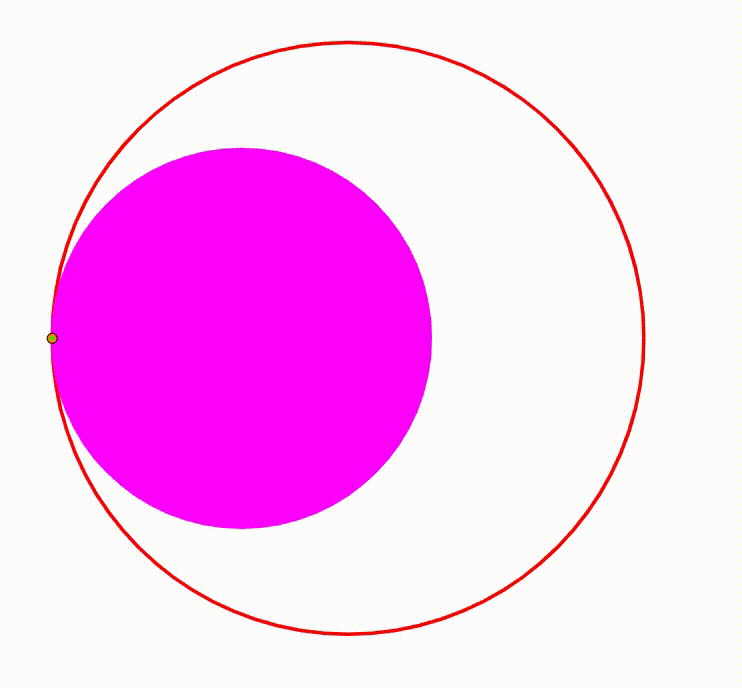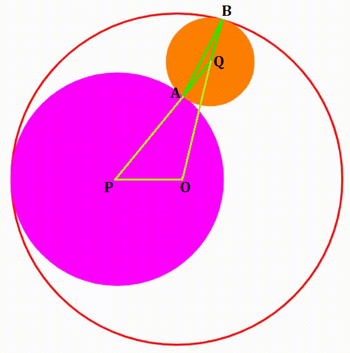Dynamic Geometry: P86
 The diagram shows a red circle with radius
2
5
and a purple circle with radius
1
6
which is internally tangent to the orange circle. The orange circle is moving freely so it's internally tangent to the red circle and tangent to the purple circle at any moment. Using its center and the tangency points, we draw a green triangle. The
maximum
value of the
sine
of the triangle's largest angle can be expressed as
q
p
, where
p
and
q
are coprime positive integers. Find
q
−
p
.
The diagram shows a red circle with radius
2
5
and a purple circle with radius
1
6
which is internally tangent to the orange circle. The orange circle is moving freely so it's internally tangent to the red circle and tangent to the purple circle at any moment. Using its center and the tangency points, we draw a green triangle. The
maximum
value of the
sine
of the triangle's largest angle can be expressed as
q
p
, where
p
and
q
are coprime positive integers. Find
q
−
p
.
The answer is 31.
This section requires Javascript.
You are seeing this because something didn't load right. We suggest you, (a) try
refreshing the page, (b) enabling javascript if it is disabled on your browser and,
finally, (c)
loading the
non-javascript version of this page
. We're sorry about the hassle.
2 solutions
Nice job sir.
Label the diagram as follows, with P , Q , and O as the centers of the circles, and let x be the radius of the orange circle and θ = ∠ P Q O :

Then P Q = A Q + P Q = x + 1 6 , O Q = O B − B Q = 2 5 − x , and O P = 2 5 − 1 6 = 9 .
By the law of cosines on △ O P Q , cos θ = 2 ⋅ P Q ⋅ O Q P Q 2 + O Q 2 − O P 2 = 2 ( x + 1 6 ) ( 2 5 − x ) ( x + 1 6 ) 2 + ( 2 5 − x ) 2 + 9 2 = − x 2 + 9 x + 4 0 0 x 2 − 9 x + 4 0 0 .
So sin ∠ A Q B = sin θ = 1 − cos 2 θ = 1 − ( − x 2 + 9 x + 4 0 0 x 2 − 9 x + 4 0 0 ) 2 = − x 2 + 9 x + 4 0 0 4 0 x ( 9 − x ) .
The maximum sine occurs when d x d y = x ( 9 − x ) ( − x 2 + 9 x + 4 0 0 ) 2 2 0 ( 9 − 2 x ) ( x 2 − 9 x + 4 0 0 ) = 0 , which is when 9 − 2 x = 0 or x = 2 9 .
At this value of x = 2 9 , sin θ = − x 2 + 9 x + 4 0 0 4 0 x ( 9 − x ) = − ( 2 9 ) 2 + 9 ⋅ 2 9 + 4 0 0 4 0 2 9 ( 9 − 2 9 ) = 1 6 8 1 7 2 0 , so p = 7 2 0 , q = 1 6 8 1 , and q − p = 9 6 1 = 3 1 .
Label the centers of large, purple, and orange circles O , P , and Q respectively, and the two tangent points of the orange circle with the other two circles A and B , Let the radius of of the orange circle be r and ∠ O P Q = θ . By cosine rule ,
O Q 2 ( 2 5 − r ) 2 ⟹ r = O P 2 + P Q 2 − 2 ⋅ O P ⋅ P Q ⋅ cos ∠ O P Q = 9 2 + ( 1 6 + r ) 2 − 2 ⋅ 9 ( 1 6 + r ) cos θ = 4 1 − 9 cos θ 1 4 4 ( 1 + cos θ )
We note that the largest sine value of △ A B O comes from the largest angle ∠ A O B , which is 1 8 0 ∘ − ∠ P Q O . Let ∠ P Q O = ϕ . Then we need to find the maximum value of sin ( 1 8 0 ∘ − ϕ ) = sin ϕ . By sine rule , we have:
9 sin ϕ ⟹ sin ϕ max ( sin ϕ ) = 2 5 − r sin θ = 2 5 − 4 1 − 9 cos θ 1 4 4 ( 1 + cos θ ) 9 sin θ = 1 6 8 1 7 2 0
Therefore q − p = 1 6 8 1 − 7 2 0 = 3 1 .